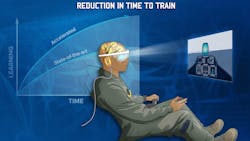Can the human brain expand its current capabilities? That is what the Air Force Research Laboratory (AFRL) at Wright-Patterson Air Force Base, OH wants to know through their Individualized Neural Learning System (iNeuraLS) project. AFRL researchers are seeking to develop a capability that will give pilots the ability to rapidly acquire knowledge and skills on the fly through direct brain interfaces, using techniques learned from studies of neurotechnology (see figure). The recently funded program is being led by the AFRL 711th Human Performance Wing (HPW) and is part of the Seedlings for Disruptive Capabilities Program (SDCP). The SDCP combines teams from across the AFRL to explore new ideas of interest to the Air Force.
“We are very excited to launch this SDCP effort,” said Dr. Gaurav Sharma, Senior Technical Lead for Cognitive Neuroscience at AFRL. “Neurotechnology is a major focus area for the 711th HPW with a huge potential for enhancing capabilities for the Air Force as we move forward.” Sharma feels the SDCP research may be close achieving a practical solution: “It may sound like science fiction, but it is rooted in science. Over the last decade we have made tremendous progress in out understanding of the brain function related to Airman performance and have also developed and tested a toolkit of neuromodulation technologies to drive the brain to an optimal performance state. With iNeuraLS, we are taking it to the next level by creating an immersive closed-loop system that will be optimized to each user’s learning potential.”
Dr. Nathaniel Bridges, AFRL research biomedical engineer and Neural Interface Team lead, explained: “We’re going to have unprecedented access to the brain using a novel brain-machine interface.” The neural signals being used in the research will also be used to develop algorithms to help the researchers determine the optimal brain state to receive information. From that point in the research program, the scientists will try to find the most effective methods for enhancing a subject’s capabilities to receive and process information.
At the end of the three-year research project, the AFRL researchers will demonstrate the effectiveness of their technology through some form of use case, such as a flight simulation. Bridges noted: “We are very excited to embark on this research and see where we can take it. This is a project with tremendous potential for the military and neuroscientific community. It is truly art inspiring science.”
About the Author
Jack Browne
Technical Contributor
Jack Browne, Technical Contributor, has worked in technical publishing for over 30 years. He managed the content and production of three technical journals while at the American Institute of Physics, including Medical Physics and the Journal of Vacuum Science & Technology. He has been a Publisher and Editor for Penton Media, started the firm’s Wireless Symposium & Exhibition trade show in 1993, and currently serves as Technical Contributor for that company's Microwaves & RF magazine. Browne, who holds a BS in Mathematics from City College of New York and BA degrees in English and Philosophy from Fordham University, is a member of the IEEE.
